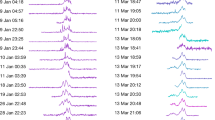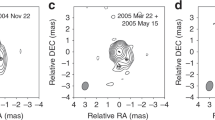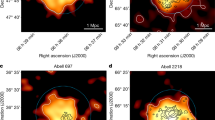Abstract
RECENTLY, Slish1 and Williams2 have shown that the curvature at the low-frequency part of the spectrum of radio sources of high surface brightness could be interpreted as being due to synchrotron self-absorption, and that frequency of maximum flux could be used to compute the angular diameter for an assumed magnetic field. The predicted angular diameters, for a field of 10−4 gauss, are in reasonable agreement with observations, except for sources such as CTA 21, CTA 102 (ref. 3), 3C 273B (ref. 4) and Parkes 1934–63 (ref. 5), for which the predicted values are well below the limits of present-day observational techniques. The latter comment also applies to the components of the sources 3C 84 and 3C 279 if their spectra are assumed to be due to synchrotron radiation.
This is a preview of subscription content, access via your institution
Access options
Subscribe to this journal
Receive 51 print issues and online access
$199.00 per year
only $3.90 per issue
Buy this article
- Purchase on Springer Link
- Instant access to full article PDF
Prices may be subject to local taxes which are calculated during checkout
Similar content being viewed by others
References
Slish, V. I., Nature, 199, 682 (1963).
Williams, P. J. S., Nature, 200, 56 (1963).
Anderson, B., Donaldson, W., Palmer, H. P., and Rowsen, B., Nature 205 376 (1965).
Shklovsky, I. S., Soviet Astronomy, 8, 638 (1965).
Shklovsky, I. S., Astro. J. (Russian), 62, 30 (1965).
Dent, W. A., and Haddock, F. T., Nature, 205, 487 (1965).
Baars, J. W. M., Mezger, P. G., and Wendker, H., Nature, 205, 488 (1965).
Twiss, R. Q., Phil. Mag., 45, 249 (1954).
Le Roux, E., Ann. d'Ap., 23, 1010 (1960).
Erickson, W. C., and Cronyn, W. M., Paper presented at the meeting of the American Astronomical Society (December 1964).
Sandage, A., and Syndham, J. D., Astrophys. J., 141, 328 (1965).
Schmidt, M., Nature, 197, 1040 (1963).
Greenstein, J. L., and Schmidt, M., Astrophys. J., 140, 1 (1964).
Ginsburg, V. L., Soviet Phys. Doklady, 9, 329 (1964).
Conway, R. G., Kellerman, K. I., and Long, R. J., Mon. Not. Roy. Astro. Soc., 125 (1962).
Author information
Authors and Affiliations
Rights and permissions
About this article
Cite this article
MENON, T. Structure of Quasi-stellar Radio Sources. Nature 206, 810–811 (1965). https://doi.org/10.1038/206810a0
Issue Date:
DOI: https://doi.org/10.1038/206810a0
This article is cited by
-
A Model of the Quasi-stellar Radio Variable CTA 102
Nature (1965)
Comments
By submitting a comment you agree to abide by our Terms and Community Guidelines. If you find something abusive or that does not comply with our terms or guidelines please flag it as inappropriate.



